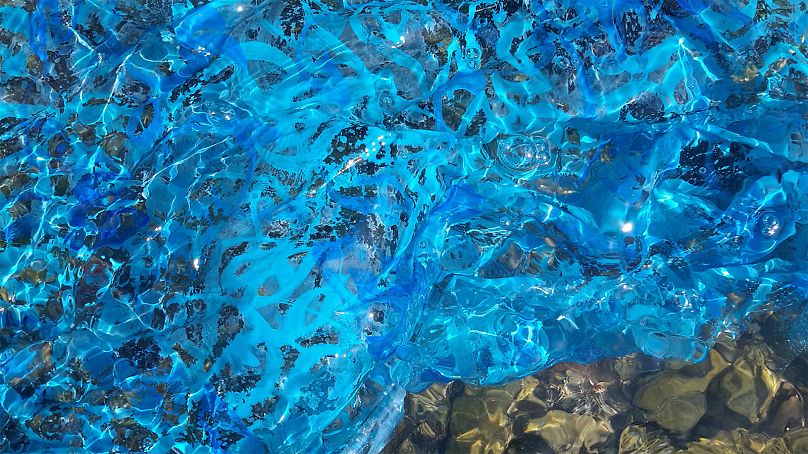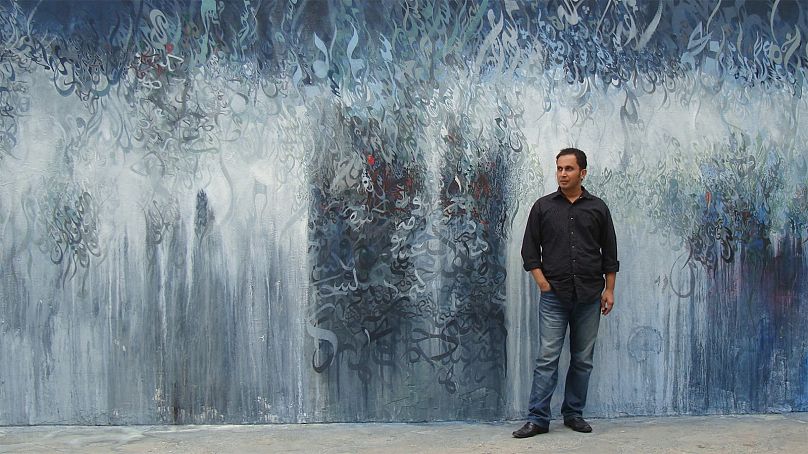A modern Arabic calligraphy exhibition at the Sharjah Museum of Islamic Civilization brings to light how the practice, that dates back to the 7th century, is moving with the times.
A modern Arabic calligraphy exhibition at the Sharjah Museum of Islamic Civilization brings to light how the practice, that dates back to the 7th century, is moving with the times.
‘Beyond the Letter’ is the result of a fruitful partnership between the Sharjah Museums Authority and the Islamic Arts Museum Malaysia [IAMM] and coincides with a calligraphy biennale which will run in the UAE until late June.
The show features key artists such as Egypt’s Ahmed Moustafa – whose pieces have hung on the walls of the British Museum and the Vatican’s University in Rome – and Japan’s Fuad Kouichi Honda, an award-winning Arabic calligrapher and leading authority on the art.
A modern take on calligraphy can also be found in the works of aspiring artists like Emirati calligrapher Narjes Nourredine.
Since the age of nine she’s been practicing designs involving the Arabic alphabet, constantly exploring new ways of fusing classical painting with colourful typography and abstract characters.
Her recent works have included a cascading metal chandelier and a 3-D printed horse made up of the poetry of Dubai’s Ruler Sheikh Mohammed bin Rashid Al Maktoum.
Nourredine’s contemporary approach to calligraphy is partly rooted in her training with master calligrapher Khaled Al Saai.
A curator, artist and world-famous expert in his field, Al Saai’s pieces have been shown in leading European, American and Middle Eastern cultural institutions. Much of his contemporary work has been inspired by both his Syrian homeland and the works of the celebrated Lebanese writer, Khalil Gibran.
Al Saai is best-known for his fearlessly avant -garde approach to the art of scribing letters. This is best demonstrated in his, “different way of teaching” students, which abandons the staid tradition of pupils repeatedly copying lines of text until they are perfected. He also encourages his students to explore new perspectives as they creative new forms of the Arabic written word.
“It's really important how the artist could do his own version, and they do it with the traditional tools - some of them on canvas or maybe as a sculpture…or 3D,” he explains.
Having taught at respected institutions all over the world, including Yale University in the United States, Al Saai apprizes how people outside of the MENA region are expressing an interest in calligraphy.
“It's a different mentality, different people, maybe different religion, different backgrounds,” he says, “So, that's important to know the way they think and the way they absorb art and they appreciate it.”
In the end, Al Saai believes it all comes down to a more fluid and open interpretation of the ancient practice:
“But the most important thing is to bring calligraphy in a very modern way.”
Unearthing the Past: Retracing the Footprints of Stone Age Emiratis
For the past forty years, archaeologists at Sharjah’s Mleiha Centre have been unearthing artefacts and burial grounds from the Palaeolithic, Neolithic, Bronze, Iron and pre-Islamic periods.
At nearby Jebel Faya – one of the world’s most ancient settlement sites - stone and flint tools from the Stone Age have also been found.
The findings allow visitors to step back in time and see how people used to live in Sharjah during the Stone Age.
The evidence of human life displayed and studied at the centre points to people’s journey from Africa, across the Red Sea to the Arabian Gulf, and onwards to populate the world through Iran, India, Asia and Europe.
“Indeed, the homo sapiens did arrive in Mleiha and lived here for a certain period of time,” explained Ajmal Hasan the centre’s education manager. “The main reason why they were migrating was because Africa was getting to be too cold, because of the last Ice Age”.
Mleiha has ambitions to secure itself a place on the list of UNESCO World Heritage Sites. Increased numbers of eco-tourists to the archeological site would be welcomed by the emirate of Sharjah, as it strives to attract ten million visitors annually by 2021.
Game-changing Rules: UAE to Grant 100% Foreign Ownership & 10-Year Visas
The United Arab Emirates’ Vice President, Sheikh Mohammed Bin Rashid Al Maktoum, has decreed that the country will allow 100 percent foreign ownership of companies.
This decision will remove the barriers to entry for many entrepreneurs, particularly for start-ups and tech companies.
According to economist Pablo Hernandez-Lagos, Professor at NYU Abu Dhabi, one of main implications is that business owners will feel more protecting of their intellectual property. Adding to this, the professor believes that not having to force partnerships with local entities could be an advantage.
“Culture is one of the main reasons why they [businesses] end partnerships sooner than expected,” he explains.
The UAE’s GDP is forecast to be around 3% next year, and it is the only country in the region to be in the top ten of the World Competitiveness Yearbook for 2018 - outperforming nations including Canada and Norway.
The emirate of Dubai, in particular, is forging ahead with its plans to build a post-oil economy and many analysts believe that the recent federal legislation could provide an extra boost to key sectors.
Also lending further support are the new 10-year UAE residency visas which will be given to some foreign investors and specialists in the fields of science, technology and medicine.
The amended residency rules are also geared to retaining young talent, allowing recent graduates to remain in the country after they have completed their studies in order to secure employment.
Social eyes: Inspired talent trending online
UAE-based Salma jumped for joy at Meliha’s Archeological Centre in Sharjah during a weekend away:
And Dubai-dweller Diaa worked on this piece of 'calligrafitii' for the Year of Zayed celebrations in Ajman.













